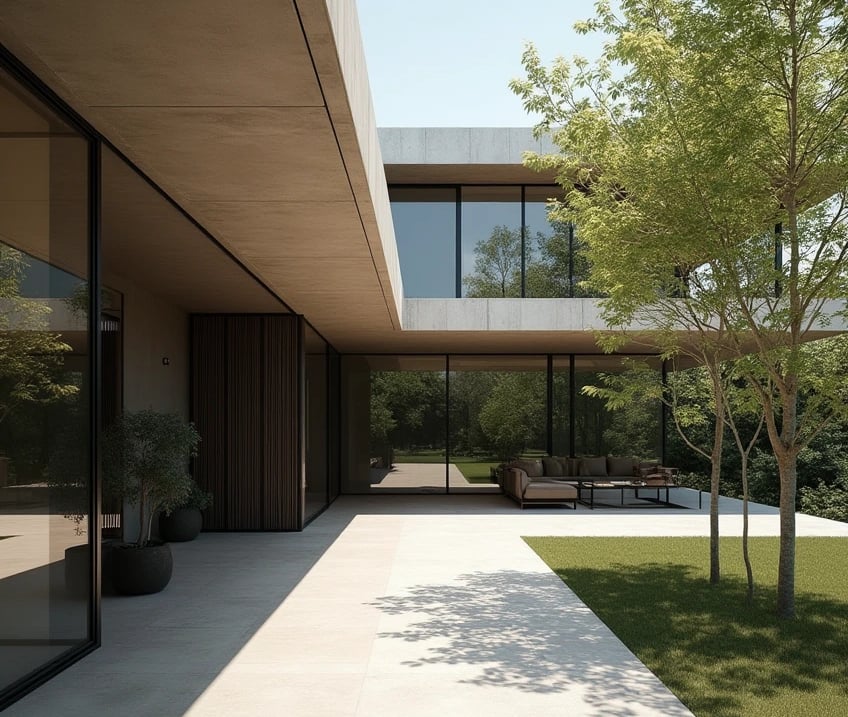Thermal Mass in Passive Design
This article explores how to adapt passive solar design principles—especially thermal mass—for Brisbane’s warm, humid climate (Zone 2). It outlines when mass helps, when it hurts, and how to combine it with shading and ventilation for comfort and energy efficiency. Practical insights for architects, designers, and developers working in subtropical regions.
6/12/20255 min read


Brisbane (NCC 2022 Climate Zone 2 – warm humid summers, mild winters) demands a focus on cooling and moisture control more than winter heating. In this subtropical climate the goal is eliminate winter heating and reduce summer cooling needs. That means rethinking heavy thermal mass: it can help moderate day–night swings, but only if shaded and purged at night. In practice, zone 2 design stresses cross-ventilation, shading and lightweight construction, with thermal mass used sparingly and strategically.
Brisbane’s Climate (Zone 2): Warm, Humid, Low Diurnal Range
Zone 2 covers coastal Queensland from Townsville/Mackay down to near Coffs Harbour. Summers are hot and humid; winters mild and often dry. Temperature swings day-to-night are moderate to low, especially near the coast (often <6°C difference). This means internal spaces stay warm and moist at night unless actively cooled or ventilated. Key design aims are to keep the home cool in summer by harnessing breezes and shading, while ensuring comfortable sleep and no extra heating in winter. In short, zone 2 passive design centres on night purge ventilation, solar control, and thermal separation – not on storing heat for winter.
Thermal Mass Strategy: Use Sparingly and Intelligently
Thermal mass can buffer peak heat by absorbing warmth during the day and releasing it at night, but only if it is actively cooled each evening. If the diurnal range is small, mass cannot cool down fully overnight and may radiate stored heat to occupants during hot nights. In fact, experts warn that high thermal mass is not recommended in warm-humid climates for purely passive cooling strategies. Unshaded mass simply absorbs internal heat by day and releases it when you’re sleeping – worsening comfort.
Best practice in Zone 2: Minimise mass in living and especially sleeping spaces unless you can flush it with cool night air. For example, bedding areas should be low-mass (lightweight materials or even elevated sleep-out spaces) so they don’t glow heat at bedtime. Concentrate any heavy mass inside the insulated core, where it can be cooled by air-conditioning or strong night breezes. If air-conditioning is used, interior mass (like concrete floors or internal brick walls) can help even out temperature swings in living areas. But in a free-running (unconditioned) home, thermal mass should be accompanied by strict solar control and very good night purge.
Ventilation & Cooling: Cross Breezes, Fans, Roof Venting
Brisbane design must maximize natural ventilation. Orient and open the house to catch prevailing breezes with narrow floor plans and large openings. All living areas should be 100% operable (louvers/casement windows) to admit air flow. Layouts with one-room depth or central hallways funnel wind through the entire section. Elevating the house (a classic Queenslander strategy) encourages airflow under floors, cooling the slab and interiors. Include ceiling fans or whole-house fans in every room; fans in the roof cavity also help purge hot air. In short, design for free-running comfort: stack vents, whirlybirds or smart roof vents remove heat from the ceiling cavity.
At night, open up the whole house (windows and ventilation shafts) to flush out stored heat from walls and floors. Even modest cooling breezes (20–22°C night air) can discharge the day’s heat from mass – but only if you haven’t insulated it off. If mass cannot be fully cooled, it will keep your home warm. Thus, combine thermal mass with high night-time ventilation to work in your favour.
Shading & Solar Control: Essential for Any Mass
In Zone 2 the sun’s heat is the enemy of passive cooling. All thermal mass must be kept out of direct sun in summer. Use deep eaves, adjustable screens or shutters and wide verandahs to shade walls and windows all year round. In practice, this means 100% shading of east/west glazing and any mass walls. Low SHGC glazing and thermally-broken frames should be used on north-facing glass to minimise unwanted heat. Consider treated reflective external cladding. Even interior mass (like tiled floors) should be shaded by covering with carpet or blinds if no breeze is available. As one guide notes, proper shading (awnings, trees, pergolas) is “important to protect thermal mass from unwanted heat gain in the summer”.
Insulation & Envelope: Keep Heat Out, Moisture Managed
Meeting or exceeding NCC insulation minima is still required, but in Zone 2 the approach is tailored to summer. Where no winter heating is needed, avoid heavy bulk insulation in external walls and ceilings – it can trap heat instead of letting it escape. Instead, use reflective foil layers in the roof/ceiling to bounce heat back outside, creating a “one-way valve” that lets indoor heat out at night. Insulate any external thermal mass by lining the inner face with insulation and/or vapour-permeable foil. This prevents daytime heat conducted through walls/slabs from radiating indoors. In other words, thermal breaks and vapour-permeable barriers are used to separate external mass from occupied spaces.
Also ensure good ventilation of enclosed spaces. Reflective foil and insulation on walls and roofs should be paired with strong roof venting to manage moisture (e.g. smart vents, attic fans). All conditioned (air-conditioned) areas should be fully sealed against leaks, and locate HVAC units in shaded spots. In sum, treat the building envelope as an “umbrella” against heat and humidity: reflective surfaces outside, insulated seals inside, and paths to vent any moisture.
Lightweight vs Heavyweight Construction
In Zone 2, the default is lightweight construction unless the site has very large day–night swings. Use timber or steel framing with minimal mass cladding, so the structure cools quickly overnight. For example, if summer nights are warm (>20°C), a double-brick wall might stay hot long after sunset, while a timber wall will shed heat rapidly. The guideline is: use mass only if the diurnal swing exceeds ~6°C. On coastal Brisbane, swings are often near or below this threshold (especially in summer), so lean lightweight.
When mass is used, follow “controlled use” practices: place it inside an insulated envelope, shade it, and pair it with ventilation. For instance, an insulated concrete slab (earth-coupled if possible) can stabilize day–night but only if its edges and underslab are well-insulated (to prevent heat seepage). Internal brick walls or tiled floors can add comfort in living areas if mechanically cooled or well-vented. In cooler, high-altitude or inland pockets of Zone 2 (where nights drop faster), more mass may be beneficial. Conversely, in the warmest coastal locations (with consistently hot summer nights), stick to light materials; let the thermal mass of furnishings and occupancy handle any minor lag.
Passive Principles Still Apply – With a Humid-Climate Twist
All the classic passive design principles are valid, but their priority flips in Zone 2. Instead of using mass to trap winter sun, focus on maximising airflow and blocking heat. Key strategies include: designing for night-time purge ventilation, maximizing openable fenestration, and extensive shading. Use ceiling fans and ventilated roof spaces to handle humidity and maintain comfort. Avoid overheating by placing heat-generating spaces (kitchens, garages) away from bedrooms, and use light colours and reflective surfaces everywhere.
Finally, always test your design with local climate models (NatHERS or equivalent) to verify you’re not inadvertently relying on mass as a “thermal battery” in what is essentially a cooling-dominated climate.
In summary: For Brisbane’s Zone 2 climate, use thermal mass sparingly and only when it can be safely purged (with shade and night ventilation). Lean on lightweight construction, wide-open ventilation, and shading to tackle heat and humidity. These adjustments ensure the original passive design intent is maintained, but optimised for a warm, humid environment.
For more details on passive design tailored to Queensland’s climate, see references below or get in touch for sustainable design consultation.
Call to Action
For architects and developers: applying these zone‑specific strategies can significantly improve comfort and performance in Brisbane homes. Follow us for more insights on sustainable design, or contact our team to discuss your project’s passive design approach.
References
YourHome (Australian Government) – Design for Climate Zones (Passive Design guidelines for Zone 2)
YourHome (Australian Government) – Thermal Mass and Passive Design (strategies for summer cooling).
Department of Climate Change, Energy, the Environment and Water (Australian Government) – Design for Your Climate and Keep Cool (Zone 1/2 tropical/sub-tropical tips).
BASC – Pacific Northwest National Laboratory – High-Thermal-Mass Construction (Building America Solution Center) (mass not advised in warm-humid climates).
Queensland Government – SmartDesign Queensland – Designing for Queensland’s Climate (Guidelines for Zone 2).
Get in touch
© Wigwam Architects
Wigwam Architects Pty Ltd ATF Wigwam Trust ABN 77 283 233 729
Wigwam Architects respectfully acknowledges the Quandamooka people as the Traditional Custodians of the land on which we live and work. We honor their enduring connection to Country, community, and culture and recognize their deep knowledge and care for this land and its waterways. We pay our respects to Elders past, present, and emerging and extend that respect to all Aboriginal and Torres Strait Islander peoples today.


